“She'd discovered a small beach far from town, with crystal-clear water and pink sand. She loved that spot. The colors of nature were so beautiful, and there was no noise. She'd leave only when the sun did too.” Il deserto rosso [Red Desert] (Michelangelo Antonioni, 1964)
Aug
12
green

Valerio (Valerio Bartoleschi) and his mother Giuliana (Monica Vitti) in an arid industrial landscape. Giuliana wears a brilliant green coat, its shade between pea and moss, depending on the drabness of her surroundings. DP: Carlo Di Palma.
Green, in food or fashion*
– Giuliana
Antonioni's first film in colour beautifully utilises Vitti's brilliance – of her auburn hair, her porcelain teint, her vivid costumes (by Paola Carloni) – against the drab landscape.
* the Bales 2025 Film Challenge for August is not date-related but lists, for the most part, the colours of the rainbow.
colours
“That's all the people we've got now. We'll get there somehow.” Хлебный день [Khlebnyy den / Bread Day] (Sergei Dvortsevoy, 1998)
Aug
10
green

The old folks pushing the cart past the hamlet's name sign. With thick brush strokes, almost too much for the small rectangle, it reads TOWNSHIP NR. 3. DP: Alisher Khamidkhodzhaev.
Green: a building or structure*
Where the old folks' hands push the cart, the green's worn off. That doesn't change anything about its importance. A lifeline, bread, is delivered once a week and with delivered, it means that the carriage is left on the rails, several kilometers away from Zhikharevo, or Township Nr. 3, which in its turn is about 80 km away from Saint Petersburg. It takes the seniors about two hours to get the wagon to their hamlet. We get to witness ten minutes or so. It lasts a lifetime.
As of 2002, only three people lived in Zhikharevo. I wonder how the wain comes home now.
* the Bales 2025 Film Challenge for August is not date-related but lists, for the most part, the colours of the rainbow.
“Tourists prefer the trendy colors, yellow and blue. Pacing fancies, hotels are painted yellow and blue. Blue wins. All women want to be fashionable. All women wear blue, except the English, those learning to swim, and the Germans, who are dedicated to green.”Du côté de la côte [Along the Coast] (Agnès Varda, 1958)
Aug
9
yellow
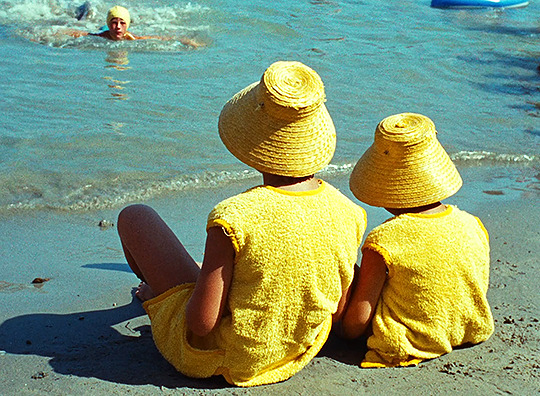
Two people, one big one small, in identical canary yellow robes and straw sun hats on the beach (more here). DPs: Quinto Albicocco & Raymond Castel.
Yellow, in food or fashion*
– narrator
* the Bales 2025 Film Challenge for August is not date-related but lists, for the most part, the colours of the rainbow.
“Just when I really needed a raincoat, he returned to my side. It would be so great if it could rain forever.”墮落天使 [Do lok tin si / Fallen Angels] (Wong Kar-Wai, 1995)
Aug
7
yellow

The killer's agent (Michelle Reis) rides an escalator in a yellow and black underground station. She wears an all-black outfit and yellow nail polish (via). DP: Christopher Doyle.
Yellow: a building or structure*
– Punkie
* the Bales 2025 Film Challenge for August is not date-related but lists, for the most part, the colours of the rainbow.
“Tell me the truth!” Ovoce stromů rajských jíme [We Eat the Fruit of the Trees of Paradise] (Věra Chytilová, 1970)
Aug
6
orange

Eva (Jitka Novákova) devouring oranges under a black umbrella (via). DP: Jaroslav Kučera.
Orange, food or fashion*
– choir
An allegorical, psychedelic retelling of Genesis 3 and the Fall of Man
* the Bales 2025 Film Challenge for August is not date-related but lists, for the most part, the colours of the rainbow.
“Today is the first day of a life of sacrifice.” 地獄門 [Jigokumon / Gate of Hell] (Teinosuke Kinugasa, 1953)
Aug
4
orange

The shrine's torii as seen in the film. Vermilion contains mercury, which not only acts as a preservative but is also believed to ward off evil. DP: Kōhei Sugiyama.
Orange: a building or structure*
– Moritoo Endō
Partially filmed near the 厳島神社 (Itsukushima Shrine) with its striking vermilion torii.
Shot on Eastmancolor, relatively cheap and globally available, and influenced by Hollywood colour melodramas of the time, in particularly Rudolph Maté's Mississippi Gambler (1953) (source), and in its turn greatly influenced the implementation of colour in global cinema to come.
Jigokumon won two Academy Awards in 1955, for Best Costume Design and Best Foreign Language Film.
* the Bales 2025 Film Challenge for August is not date-related but lists, for the most part, the colours of the rainbow.
“She looked at the red shoes, for she thought there was no harm in looking. She put them on, for she thought there was no harm in that either. But then she went to the ball and began dancing. When she tried to turn to the right, the shoes turned to the left. When she wanted to dance up the ballroom, her shoes danced down. They danced down the stairs, into the street, and out through the gate of the town. Dance she did, and dance she must, straight into the dark woods.” The Red Shoes (Michael Powell + Emeric Pressburger, 1948)
Aug
3
red
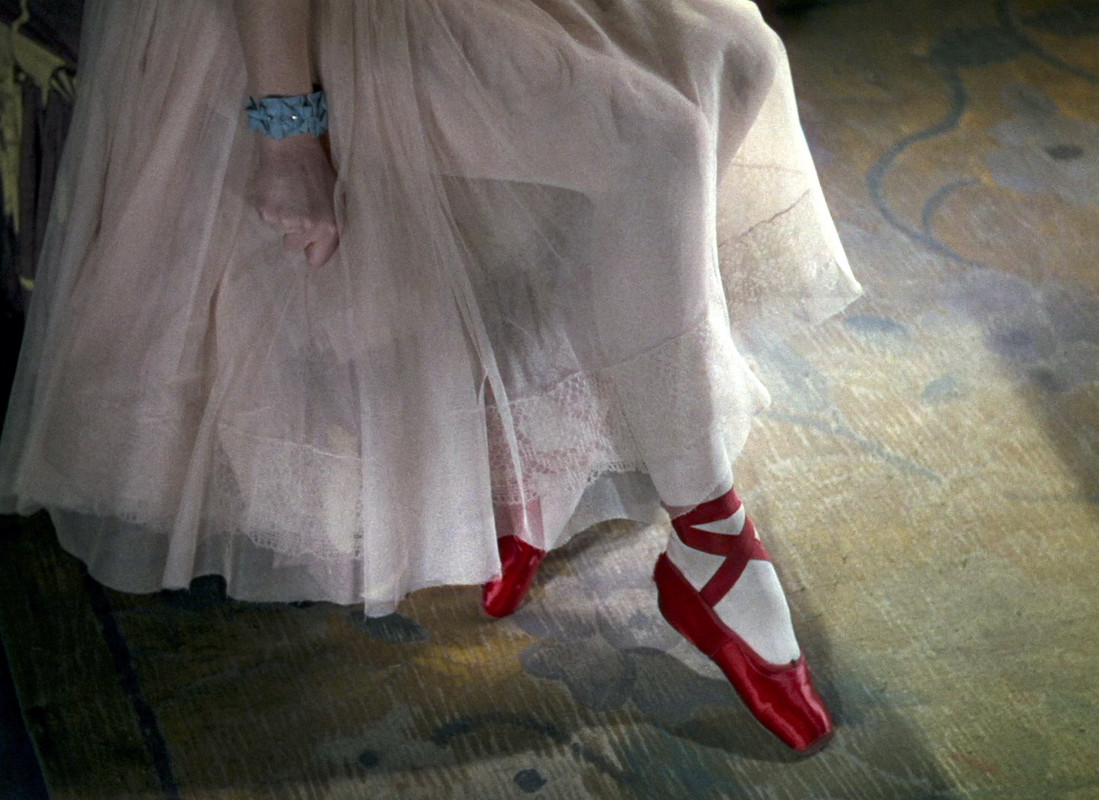
A ballerina's lower body in focus. She wears a long tulle off-white dress, slightly sheer, with her white stockings showing through slightly. Part of her right lower arm is visible, the hand clutched, a turquoise bracelet on the wrist. What stands out most are her ruby red ballet shoes that appear to move away from her. The backdrop is a dull, washed out carpet. DP: Jack Cardiff.
Red: best use of red in food or fashion*
– Hans Christian Andersen, De røde Skoe (1845, tranl. Jean Hersholt, 1949), via
Another one of The Archers' #Technicolor extravaganzas. This time, not to wow the worn-down post-war black-and-white audience, but as an an active storytelling instrument.
Built around Hans Christian Andersen's haunting tale De røde Skoe (1845).
* the Bales 2025 Film Challenge for August is not date-related but lists, for the most part, the colours of the rainbow.
“It's just a dream, Agnes.” Viskningar och rop [Cries and Whispers] (Ingmar Bergman, 1972)
Aug
1
red
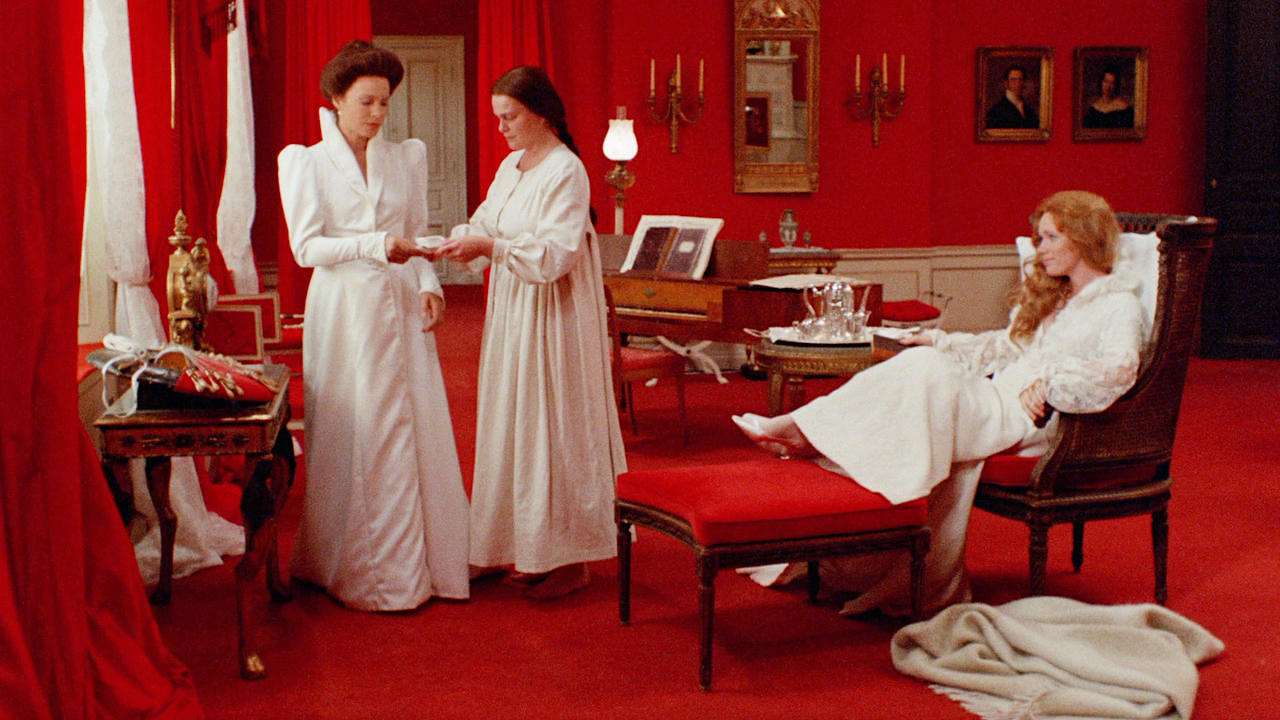
The three sisters in the red room (via). DP: Sven Nykvist.
Red: a building or structure*
– Anna
Red as an expression of inner and outer worlds. Even the scene transitions are red.
* the Bales 2025 Film Challenge for August is not date-related but lists, for the most part, the colours of the rainbow.
“Paris, Paris, Paris
C'est sur la Terre un coin de paradis
Paris, Paris, Paris,
De mes amours c′est lui le favori
Mais oui, mais oui, pardi
Ce que j'en dis on vous l′a déjà dit
Et c'est Paris, qui fait la parisienne
Qu′importe, qu'elle vienne du nord ou bien du midi
Et c'est aussi le charme et l′élégance
Et l′âme de la France
Tout cela, mais c'est Paris”Touki bouki [Journey of the Hyena] (Djibril Diop Mambéty, 1973)
Jun
23
National Pink Day
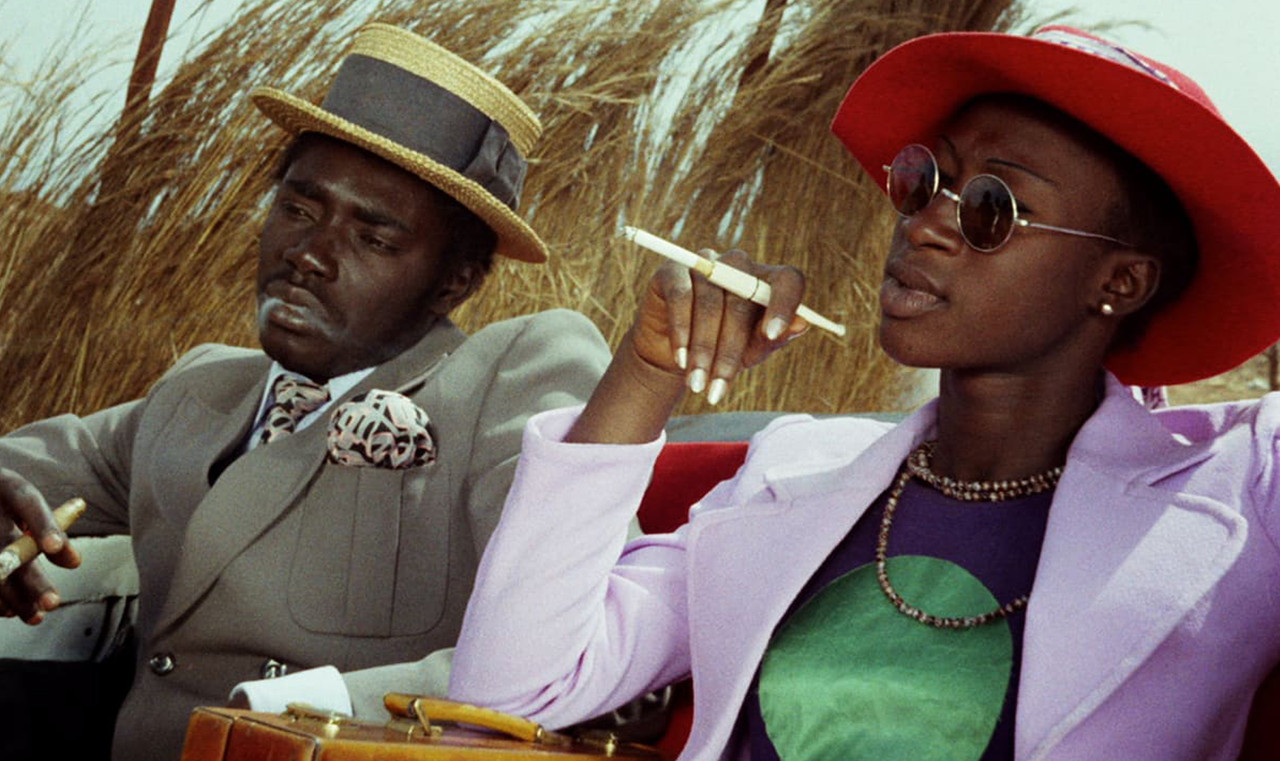
Mory (Magaye Niang) and Anta (Myriam Niang) in romanticised European outfits. DP: Georges Bracher.
A character wearing pink on National Pink Day (USA), not to be confused with the much more poignant International Day of Pink
Joséphine Baker, Paris, Paris (Georges Zacharie Tabet)
Cowherd Mory and student Anta journey from Dakar to their new destination, the city of Paris.
“He remembers those vanished years. As though looking through a dusty window pane, the past is something he could see, but not touch. And everything he sees is blurred and indistinct.”花樣年華 [Fa yeung nin wah / In the Mood for Love] (Wong Kar-Wai, 2000)
Mar
17
Irish-American Heritage Month
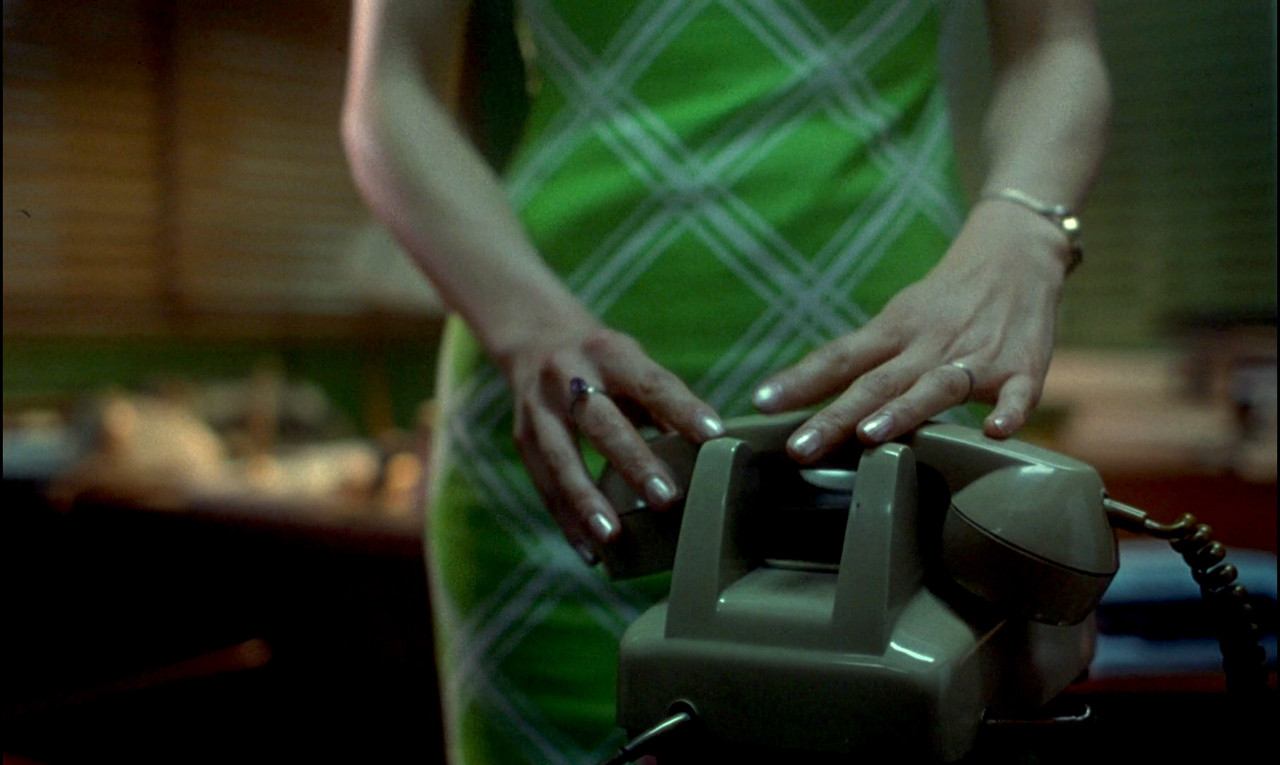
A close-up of a pea-green phone with Mrs. Chan's (Maggie Cheung) hands resting on the receiver. Her dress is a bright green, with an abstract graphic in white. DPs: Christopher Doyle, Pun Leung Kwan & Ping Bin Lee.
Green for Irish-American Heritage Month (USA)
– caption